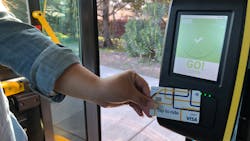Open for All: The Modular Route to Contactless Open Loop Fare Payments
Transit agencies around the world are starting to see an alternative to single vendor contracts when procuring fare collection systems. Modular components, supplied by specialist vendors and integrated within an open architecture, are emerging as a faster, less expensive and more flexible option.
Design and build options
Until recently, the market for providing automated fare payments was dominated by big fare collection system vendors. Once contracted, they entered long-term relationships with customers, managing the entire project throughout the design, build, operate and maintain phases. These projects are typically built to detailed specifications, can take years to deploy and can include associated costs that prove prohibitive to smaller agencies.
While it can be reassuring to have only one vendor to engage with, agencies are locked into contracts for many years, and modernization can become a challenge.
The transit industry has looked to other sectors for an example of a more agile solution. Modular systems, the norm in retail payments for decades, provide a faster, more cost-effective approach, which can be replicated for fare collection.
An alternative model
Transit operators and agencies of all sizes are choosing to buy solutions for contactless fare payments in a number of lots, which plug-and-play together through open APIs. This means they engage several vendors who are best in class in a specialist area, such as device hardware, payments processing and merchant services. With tried and tested integrations and standard contracts, a contactless EMV pilot or roll-out can be managed in weeks.
Where the single supplier model can be highly constrained, the modular alternative allows greater flexibility. If an agency prefers a particular payment reader, the option to use it remains. Interoperability, choice and competition in the marketplace drives costs down, making contactless EMV something that small transit agencies can consider.
Industry moving towards modular
Some of the biggest players in public transit have shown interest in moving towards more modular solutions based on open standards. Transport for London (TfL) has suggested that, in a procurement taking place in 2025, it will look to segment its monolithic solution.
Agencies already spearheading this approach include Helsinki Regional Transport (HSL) and TVV lippu- ja maksujärjestelmä Oy (LMJ) in Finland. They rolled out a modular contactless payment system in the capital, Helsinki, and several other cities.
To introduce contactless EMV transit payments, public transit agencies need three components: a validator (payment terminal to accept payment), a payment processor (the integration layer) and an acquiring bank (to settle the payment). In Finland, the payment processor connected Nets, a leading European provider of acquiring services, to several different validators, allowing each city’s transit provider to select the hardware that matched their needs.
Because integration and certification were already complete, transit agencies in cities such as Tampere, Oulu and Hämeenlinna were able to quickly get up and running with contactless acceptance.
"We can promise our [transit agency] customers that, six weeks after project ramp-up, we can start production with Mastercard and Visa payments," said Juha Ranta, COO, LMJ.
Strong contactless payments adoption was seen from the outset, with contactless EMV payments gaining a 17 percent share of total transactions in the city of Oulu within 10 months - while paper tickets and season passes saw the greatest decline. This is partly because consumers in the Nordic region already widely use tap-to-pay in settings like retail and hospitality and there was pent up demand for the same experience on public transport.
However, the cities involved also launched dedicated customer-facing marketing campaigns, helping to motivate the significant shift to contactless. Campaigns including billboards, bus wraps and other communications ensured that residents, commuters and tourists knew the system was being introduced and were clear on how to use it.
In the United States, the California Department of Transportation (Caltrans) is also breaking new ground with a mobility marketplace set up as part of the California Integrated Travel Project (Cal-ITP). It has contracted vendors in three categories - payment processors, fare calculation software and fare validators - to supply parts of an open loop fare collection system. Any of the 300-plus transit agencies in the state—and nationwide—can pick three compatible components to buy.
It is hoped that, in making contactless payments less complex to procure and more affordable for smaller cities, the state of California will work towards a unified transit payments system. Its long-term vision is to achieve seamless, multi-modal travel in the state and beyond, inspiring more people to ride transit rather than using their private car for most journeys.
Early signs are encouraging. Several contactless pilots have gone live in Monterey, Sacramento and Santa Barbara, which demonstrate the modular concept in action. Monterey Salinas-Transit (MST) led the way, launching tap-to-pay in May 2021. In a rider survey carried out a year later, the agency found that nearly half (47 percent) of respondents were using the system and found it really convenient.
Lisa Rheinheimer, assistant general manager, MST, said, “Those who use the contactless system are largely happy with it.”
In Santa Barbara, a contactless system has been active on the Santa Barbara County Association of Governments’ (SBCAG) Clean Air Express commuter route since last July. It has steadily gained users and now 13 percent of riders tap-to-pay.
Whitney Rush, rail and transit project manager, SBCAG, said, "It’s been enormously beneficial to step into the future of fare payments. Our customers expect it. They and the drivers have been pleased with the system.”
Open for all agencies
Open architecture for payment systems is the way that the industry is headed, making it possible to launch tap-to-ride quickly and less expensively, and enabling agencies to add to or swap elements of a fare collection system without having to start from scratch.
For those without access to a state-led initiative such as Cal-ITP’s mobility marketplace, procurement options include issuing separate RFPs for payment devices, payment processing and acquiring services; or working with a payment service provider that has established integrations with a range of devices and acquirers. Following the latter route, it’s possible that components of an open loop payments system can be selected and then simply switched on.
The Californian contactless demonstrations are a great example of this. In partnership with Cal-ITP, payment service provider Littlepay teamed up with its ticketing technology and acquiring partners to give agencies a smooth journey to contactless EMV.
The beauty of this type of arrangement, particularly for smaller agencies with limited technical resources, is that there is knowledge and experience on tap. Systems have been deployed many times already and there is a clear and proven roadmap for both pilots and full roll-outs.
Simple and inclusive fare payments
Fast becoming an expectation amongst transit users around the world, contactless EMV payments have been identified as a pillar of the rider experience. These systems allow speedy boarding and the convenience of tapping to pay for trips using the bank card or digital wallet people carry everywhere. Riders simply pay for travel, rather than buying a ticket, and enjoy automatic benefits from fare caps or discounts and concessions linked to their card.
As U.S. transit agencies continue to seek ways to improve fare equity and inclusion, this technology is at the forefront of enabling lower income riders and eligible concession groups to access public transit and get the best ticket prices without paying in advance. Modular systems, with minimal capex investment and fast turnaround from contract to deployment can give transit agencies in smaller urban and rural communities an ace up their sleeve.
Adam McGavock is the business development manager for North America at Littlepay.
About the Author

Adam McGavock
Business Development Manager North America, Littlepay
Adam McGavock is the business development manager for North America at Littlepay. He served as planning director at the Northern Virginia Transportation Commission and has since gained two decades of transit payments expertise. He was director of customer service, sales and fare media at the Washington Metropolitan Area Transit Authority, overseeing payments experience (resulting from 1.3 million daily transactions). He later joined the IBI Group as a senior project manager, specializing in fare payments and customer service. Progressing to Moovel NA, a provider of mobile ticketing, he became director of business development. Before joining Littlepay, he provided fare payments consultancy to AECOM.
